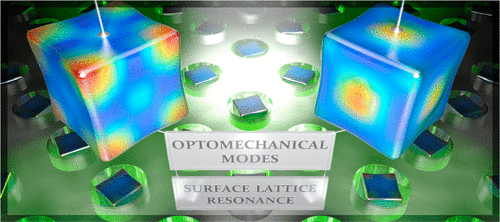当前位置:
X-MOL 学术
›
ACS Photonics
›
论文详情
Our official English website, www.x-mol.net, welcomes your
feedback! (Note: you will need to create a separate account there.)
Effect of Ag Nanocube Optomechanical Modes on Plasmonic Surface Lattice Resonances
ACS Photonics ( IF 6.5 ) Pub Date : 2020-10-20 , DOI: 10.1021/acsphotonics.0c01187 Mindaugas Juodėnas 1 , Domantas Peckus 1 , Tomas Tamulevičius 1, 2 , Yusuke Yamauchi 3, 4 , Sigitas Tamulevičius 1, 2 , Joel Henzie 4, 5
ACS Photonics ( IF 6.5 ) Pub Date : 2020-10-20 , DOI: 10.1021/acsphotonics.0c01187 Mindaugas Juodėnas 1 , Domantas Peckus 1 , Tomas Tamulevičius 1, 2 , Yusuke Yamauchi 3, 4 , Sigitas Tamulevičius 1, 2 , Joel Henzie 4, 5
Affiliation

|
Noble metal nanoparticles patterned in ordered arrays can interact and generate hybrid plasmonic–photonic resonances called surface lattice resonances (SLRs). Dispersion curves help explain how the Bragg coupling conditions and radiation patterns create dipolar and quadrupolar SLRs, but they assume that the nanoparticles are static structures, which is inaccurate at ultrafast time scales. In this article, we examine how local surface plasmon resonances (LSPRs) supported by cubic Ag nanocrystals are modulated by ultrafast photophysical processes that generate optomechanical modes. We use transient absorbance spectroscopy measurements to demonstrate how the LSPRs of the nanoparticles modulate the SLR of the array over time. Two primary mechanical breathing modes of Ag nanocubes were identified in the data and input into electromagnetic models to examine how fluctuations in shape affect the dispersion diagram. Our observations demonstrate the impact of optomechanical processes on the photonic length scale, which should be considered in the design of SLR-based devices.
中文翻译:

Ag纳米立方体光机械模式对等离子表面晶格共振的影响。
在有序阵列中图案化的贵金属纳米粒子可以相互作用并产生称为表面晶格共振(SLR)的混合等离子-光子共振。色散曲线有助于解释布拉格耦合条件和辐射方向图如何产生偶极和四极单反相机,但它们假设纳米粒子是静态结构,这在超快时间尺度上是不准确的。在本文中,我们研究了立方银纳米晶体支持的局部表面等离子体激元共振(LSPR)如何通过产生光机械模式的超快光物理过程进行调制。我们使用瞬态吸收光谱法测量来证明纳米粒子的LSPRs如何随时间调节阵列的SLR。在数据中确定了两种主要的Ag纳米立方体机械呼吸模式,并将其输入电磁模型中,以检查形状波动如何影响分散图。我们的观察结果证明了光机械过程对光子长度尺度的影响,这在基于SLR的设备设计中应予以考虑。
更新日期:2020-11-18
中文翻译:

Ag纳米立方体光机械模式对等离子表面晶格共振的影响。
在有序阵列中图案化的贵金属纳米粒子可以相互作用并产生称为表面晶格共振(SLR)的混合等离子-光子共振。色散曲线有助于解释布拉格耦合条件和辐射方向图如何产生偶极和四极单反相机,但它们假设纳米粒子是静态结构,这在超快时间尺度上是不准确的。在本文中,我们研究了立方银纳米晶体支持的局部表面等离子体激元共振(LSPR)如何通过产生光机械模式的超快光物理过程进行调制。我们使用瞬态吸收光谱法测量来证明纳米粒子的LSPRs如何随时间调节阵列的SLR。在数据中确定了两种主要的Ag纳米立方体机械呼吸模式,并将其输入电磁模型中,以检查形状波动如何影响分散图。我们的观察结果证明了光机械过程对光子长度尺度的影响,这在基于SLR的设备设计中应予以考虑。











































 京公网安备 11010802027423号
京公网安备 11010802027423号